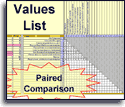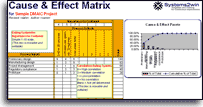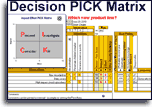Installation and Setup
Installation - Each User. Installation - Multi-user. Language Translations. Personalize Your Templates.Systems2win Training.
Quick Start Initial Training. New User Training. Training Matrix. Systems2win Leadership. Training Classes.Lean Training
Lean Training and Coaching. Lean Principles. Muda 8 Wastes. Goal - Lean Flow. Roadmap - Lean Journey. Value Stream Mapping. Standard Work. Hansei Lean Thinking. Lean Dictionary. Online Lean Training. Lean Leadership.Microsoft Office Training
Excel Training. Excel Drawings (without Visio). Excel Charts. Word Training. PDF Training. Document Storage and Naming.Support
Support.Decision Making Tools
Decision techniques, and guidance for selecting the right decision making tool
Contents
Search
Use CTRL+F to find keywords
Tools for Decision Making
Decision Matrix - Quadrant Chart
aka PICK Matrix, Impact Effort Matrix
The most popular decision making tool, because it visually charts alternatives into quadrants based on Impact and Effort to Proceed, Investigate, Consider, or Kill
Learn more about the Decision Matrix template,
which is also the right tool for Lean Project Prioritization
Decision Matrix - Simple
A simple way to apply a systematic approach for making many diverse types of choices.
Simply list the Objectives and weights of Importance in columns, and list your Alternatives in rows, and then use your chosen Rating system to answer the question:"How well does each Alternative meet each Objective?"
Learn more about the Decision Matrix template

Values List
aka Forced Choice, Paired Comparison, Values Ranking worksheet
To prioritize a long list of choices
especially when subjective personal preferences are very important.
Often used to prioritize potential evaluation criteria that you might then use within another decision-making tool
Learn more about the Values List Worksheet

Prioritization Matrix
Can also be used to prioritize a long list of choices.
The most thorough decision making method — to use when there are serious consequences for a wrong decision.
Learn more about the Prioritization Matrix

Quadrant Chart
To visually understand relationships between any two factors affecting an issue.
There are many types of quadrant charts, including:
- Plan-results, and effective-achievement analysis for selection and/or evaluation of goals or projects
- Importance-performance, and perceptual maps for listening to the voice of the customer
Learn more about the Quadrant Chart template

To Do List
The To Do List has two (optionally unhidden) columns for Important and Urgent with color-coded conditional formatting to help you prioritize using the logic of an Eisenhower Matrix

More Decision Making Tools
It could be argued that every continuous improvement tool is actually a tool for making some type of decision.
Here are a few that deserve special mention...
A3 Report
Although the A3 Report is best known as a problem solving tool,
it is also a very powerful tool (and method) for decision making
and no matter which decision making tools and methods were used, an A3 Report provides a ideal way to 'tell your story' of what problems were faced, what root causes were identified, what goals and targets were chosen, what options were considered, why you made your choice, how your changes were implemented, and expected vs. actual measured results.
All on one page.
Force Field Analysis
Use your Force Field Analysis template to make better decisions based upon a better understanding of the psychological forces within the workplace.

Tree Diagrams
A tree diagram is an excellent tool to graphically depict a decision tree that has simple, uncomplicated branches.

Decision Logic Flow Chart
If the branches aren't so simple,
then a Decision Logic Flow Chart is a better choice.

Matrix template
A simple Matrix template can be personalized to analyze just about anything.

And more Decision Making Tools
Cause and Effect Matrix
The Cause & Effect Matrix is a special type of Pareto Chart
to answer the common question "what do our customers want from us?"

House of Quality – QFD
The House of Quality QFD answers the same question
"what do our customers want from us?"
but more thoroughly.
And features a "roof" to identify Alternatives that reinforce or conflict with each other.

Scatter Plot X-Y Graph
You can use the Correlation Analysis section of your Scatter Plot template
to determine whether or not two decision-making variables might be correlated.

Histogram
You can use your Histogram template
to look for patterns within the observations of your data.

Strategic Planning Tools
The biggest decisions are strategic.
And these strategic planning tools provide structure and systems to focus your team's thinking.

Value Stream Mapping
Value Stream Mapping is a strategic tool to answer the all-important question:
"Where should we focus our attention?"
(What continuous improvement projects will yield the most benefits to our customers?)

Rating Scales
You can use any of the following rating scales for just about any decision tool.
Tip: You can optionally personalize your master template with your preferred rating scale — in a way that your rating scale will be automatically found and transferred to your new master template each time that you upgrade.
1,2,3 or 1,2,3,4,5
On your DV worksheet (where you define your dropdown lists), simply specify what each rating criterion means
1,3,9 or 1,4,9
A popular method to increase differences between options
Rank order
Rank order all or specified number of options — with highest number for the highest priority, and 1 being the lowest.
Pugh Matrix
Establish a baseline (perhaps current conditions, or one of the options...)
For each criterion, rate each option in comparison to the baseline.
–1 if worse
0 if same
1 if better
You can optionally establish a finer scale.
For example, –2 or –3, rather than just –1
Decision Techniques
Selecting the right decision making process
Most of the following techniques can be used with or without a decision making tool.
Group Decision Making
In addition to the more systematic tools & approaches, the three most popular simple decision methods are:
- Autocratic decision
The leader considers the options, and makes the decisions.
- Democratic majority vote
Either simple majority, or any moderating rules you come up with.
Sometimes results in hard feelings and/or sabotage.
- Consensus
Everyone agrees to support a decision, even if not their personal top choice.

Brainstorming and Root Cause Analysis
Before making a decision, it is often good practice to do brainstorming, and/or root cause analysis.
List Reduction
The simple techniques for list reduction should always be used first.
If there are still too many options...
then you can use the Values List template or Prioritization Matrix to prioritize and narrow down your list, and/or one or more of the following decision making techniques.
Criteria Filtering
When to use
- To reduce a list of options to a smaller list, or...
- To select a final choice for a decision that is not worth the time for a more rigorous analysis.
How
- Brainstorm criteria for evaluating your options
and discuss to arrive at your final list of evaluation criteria.Ideally, questions are phrased to be answered with a "yes" or "no" — with "yes" being the desired answer, but there can be exceptions to this.
- Reach consensus to rank order the evaluation criteria — from most important to least.
- Create an L-shaped matrix of options and (rank ordered) evaluation criteria.
- Evaluate each option against each criterion.
Usually, by asking the question, "Does this option satisfy this criterion?"
If there is disagreement, tally votes.Start with the most important evaluation criteria, and work your way down.
You might reach consensus before wasting time on less important criteria. - Discuss, and reach consensus.
If unable to reach consensus, perhaps use a more rigorous decision-making tool and/or method.
Multi-voting
When to use
- After generating a list of options, and using the usual simpler methods to reduce the list
- To reduce a list of options to a smaller list, or...
- To make a decision based on group deliberation
How
- Display the entire list of options
Perhaps assign a number or letter to identify each item.
- Each team member selects five items (or other specified number of allowed choices)
Write all five on separate pieces of paper — along with priority ranking for each choice.
Highest number has highest priority.
- Tally the votes
Collect votes. Shuffle them. Write priority ranking number next to each item. Total the weighted votes.
- If decision is not obvious — discuss
To avoid hard feelings or sabotage, seek consensus, rather than simply outvoting the minority voices.
If agreement is not easy... either repeat multi-voting after discussion, or use a different decision making method.
Plus Minus Interesting (PMI)
When to use
- When evaluating an option
- Especially when the group (or an individual within the group)
seems able to see only the one-sided advantages or disadvantages of the option
How
On a flip chart... one phase at a time... (don't skip back & forth between pluses and minuses)...
- Brainstorm pluses — that favor the option
- Brainstorm minuses — challenges of the option
- Brainstorm interesting aspects of the idea — neutral aspects, or questions to investigate
Suggested Reading and Resources for
Decision Making Tools
- What Color is Your Parachute, by Richard Bolles
- The Six Sigma Way Team Fieldbook, by Peter Pande

These decision making tools come with many other templates for lean leadership and process improvement
to empower every team member to improve every process

Can we wait to start
this project?
I haven't finished
making my tools.
Own Yours Now
If your organization has
not yet provided a license,
own yours now
Training and Coaching
Consider Training and Coaching to support your teams to succeed

Training to get you started.
Tools you won't outgrow.
Schedule a Conference
Schedule a conference
to discuss your challenges
with an experienced lean advisor














